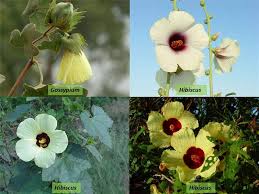Habit: Herbs, shrubs, and trees. Leaves simple, alternate, and palmately-veined; stipules 2, free lateral. Flowers regular, poly-petalous, bisexual, hypogynous, copiously mucilaginous, with a whorl of bracteoles known as the epicalyx (except in Abutilon and Sida). Calyx—sepals (5), united, valvate.
Corolla (petals 5), free, attached to the base of the staminal tube; aestivation twisted. Androecium stamens numerous, monadelphous, i.e., united into one bundle called staminal column or tube, epipetalous (staminal tube adnate to the petals at the base); anthers reniform, unilocular; pollen grains large and spiny.
Gynoecium (carpels) commonly (5 to ∞), syncarpous, (2-3) in Kydia; ovary superior, 5- to ∞-locular, usually 5-locular, with 1 to many ovules in each loculus; placentation axile; style passes through the staminal tube; stigmas free, as many as the carpels. Fruit a capsule or sometimes a schizocarp. Seed endospermic.
Floral formula—®⚥K(5)C5A(∞)G(5-∞). Malvales may be allied to Guttiferales by various degrees of union of stamens, 5-merous calyx and corolla, and hypogynous flowers, and may have a common origin.
Read Also: Chiggers: Description, Damages Caused, Control and Preventive Measures
Economic and Ornamental Plants of the Malvaceae Family
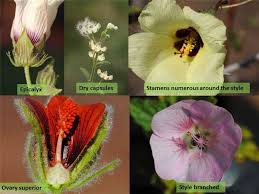
Examples: Larger genera include Hibiscus (over 200 sp.), Sida (200 sp.), Abutilon (100 sp.), and Malva (40 sp.). Useful plants: Gossypium (20 sp.) yields commercial textile cotton, rozelle (Hibiscus sabdariffa) fruits used for a sour jelly, Madras or Deccan hemp (H. cannabinus) a source of strong fibers.
Musk mallow (H. abelmoschus; B. MUSHAKDANA; H. MUSHAKDANA) seeds smell like musk and are used as a flavoring agent and as a medicine, mallow (Malva verticillata) cultivated as a winter vegetable, lady’s finger (Abelmoschus esculentus) green fruits used as a vegetable.
Ornamental: Several species of Hibiscus, e.g., shoe-flower or China rose (H. rosa-sinensis), H. mutabilis (B. STHALPADMA; H. GUL-AJAIB), H. radiatus, Chinese lantern (Achania malvaviscus; B. LANKAJABA), and hollyhock (Althaea rosea); shade tree: Portia tree (Thespesia populnea).
Other common plants: Sida cordifolia, S. rhomboidea, Urena lobata, Hibiscus vitifolius (B. & H. BAN-KAPAS), Indian mallow (Abutilon indicum; B. PETARI; H. KANGHI), Malachra capitata (B. & H. BAN-BHINDI), and Malvastrum spicatum common weeds of waste places.
Botanical Features of the Sterculiaceae Family in Agriculture
Habit: Shrubs or trees, rarely herbs. Leaves and stipules are like those of Malvaceae. Inflorescence cymose, often complex.
Flowers regular, sometimes zygomorphic, bisexual, rarely unisexual (as in Sterculia), hypogynous.
Calyx and corolla as in Malvaceae, sometimes corolla absent; no epicalyx. Androecium stamens usually ∞ (but varying from 5-25), typically in two whorls, the outer whorl opposite to sepals and often reduced to staminodes or absent, while the inner whorl opposite to petals, fertile and often branched; all stamens more or less united below into a tube; sometimes on gonophore.
Cotton Fibers: Origin and Economic Importance
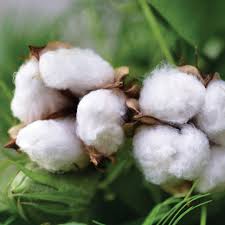
Cotton is a seed fiber whose exact origin is not known. It probably originated in the drier parts or even in the desert areas of the world. Some cotton, however, is indigenous to Africa. Cotton is an important cash crop in Nigeria, Ghana, and Sierra Leone.
The two most important commercial cotton species are G. hirsutum (American Upland Cotton) with relatively short fiber, 1.2-2.5 cm staple length; and G. barbadense (Egyptian or Sea Island Cotton), which produces the finest lint (the hairs which grow from the seed coats) with a staple length of 5 cm or more.
Cotton lint is used in the manufacture of textiles. Many textile factories, using mainly locally-produced lint, exist in Nigeria, Ghana, and Cote d’Ivoire.
The cotton lint requirement of these factories is so great that some West African countries, e.g., Nigeria, have become net importers of cotton. Even before the advent of European traders, locally-woven attractive cloths using West African cotton flourished in Nigeria, Ghana, and Sierra Leone.
The lint was spun into long threads which were dyed, before being woven into ‘Kente’ or ‘Aso-oke’ cloths. The short hairs, called fuzz or linters, which are removed after further ginning, are used for making cellulose acetate, rayon, carpets, and in the manufacture of upholstery.
Cotton seed oil forms about 25 percent of the seed. It is a semi-drying oil used after refining as cooking oil or in the manufacture of soap and margarine.
The residue after oil removal is called cotton seed cake. It contains up to 5 percent nitrogen and is rich in protein. It can be fed to livestock as a concentrate for milk production or used in the manufacture of nitrogenous fertilizers.
Raw cotton seed contains a poisonous substance called gossypol. It should therefore not be fed to livestock, especially the young ones which are more susceptible to this poisoning.
Climatic and Soil Requirements for Cotton Cultivation
Cotton will grow well on a wide range of soils but is better on fertile, well-drained deep loams and clay loams with pH of 5.7-8.0. Water and nitrogen are two important factors which affect the yield of cotton. Its water requirement varies with the spacing, temperature, and soil conditions.
It requires little water during the first two months, when its leaf area is small, but its need increases at flowering, reaching a peak some six weeks later. Thereafter, the water requirement declines.
Inadequate water supply during the third, fourth, and fifth months in the field can lead to premature shedding of leaves, flowers, buds, and bolls and to the development of short immature lint.
High rainfall is undesirable as it encourages increased disease and pest attack and discoloration of the lint.
Read Also: Scrapie in Sheep and Goats: Description, Damages Caused, Control and Preventive Measures
Cotton Varieties Grown in West Africa
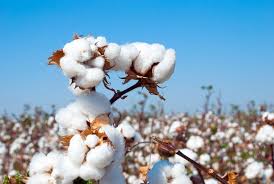
Most cotton introduced to West Africa belongs to the short staple American Upland Cotton type. The best known of these is the Alien type from which the improved Nigerian Alien (N.A.) 26C was bred.
It is the commercial cotton of the northern areas of Nigeria, has a short fiber, and yields up to 560 kg cotton seed per ha on government farms but only 112-224 kg per ha on small farm holdings. The recommended varieties in Ghana are BJA 592 and Alien 333.
Nigerian Ishan (N.I.) is an indigenous cotton with short fiber selected from cotton in the Ishan district of Benin in Edo State of Nigeria. Botanically, it is G. vitifolium.
It is a tall, bushy plant (shrub) with deep yellow flowers and has a longer and silkier fiber than the average locally grown cotton of southern Nigeria, e.g., the Meko type (G. peruvianum). It performs better than the Alien type when intercropped.
Cultivation Practices for Cotton in West Africa
Cotton is sown alone or intercropped with other crops such as maize or yam. It is always grown in rotation with other crops. In Ghana, a three-year rotation (A Cotton, B Cowpeas or Soyabeans, and C Maize), or a four-year rotation (A Cowpeas, B Groundnuts, C Cotton, and D Sorghum) is followed. Sowing date, spacing, and thinning are extremely important.
Spacing varies with the area and cotton variety. For a sole crop, 90 x 30 cm or 75-105 cm apart on ridges are used, but close spacing promotes an early yield. In July, 6 to 10 seeds are sown per hole at a depth of 2 cm giving a seed rate of 17.0-22.5 kg per ha.
The seed rate in Nigeria is even higher, thus raising the cost of production. Seeds germinate in 4–6 days. The seedlings are thinned to one to two per stand when 3 weeks old and 10-15 cm high to prevent excessive competition among the plants for nutrients.
Weeds are removed, and mulching with grass or weeds is helpful. Flowering occurs 2 to 1½ months after field planting. Pollination occurs during the day, and the first bolls open 1½ to 2 months later.
Picking is done by hand as soon as enough bolls open fully, and the lint is dried properly. This is usually at the end of January in northern areas of Nigeria but extends to March and April in southern areas of Nigeria.
Frequent picking is desirable to reduce insect attack. A good picker will pick 27-32 kg per day, and one picker will be needed to cover 1.6 ha.
Processing Techniques for Cotton Harvest
After harvesting, the seed cotton is ginned (i.e., the lint is removed from the seed and fuzz).
Two types of gins can be used: saw gin for the shorter staple American Upland Cotton in which the lint is very firmly attached to the seed; and roller gin for the longer staple cotton in which the lint is more easily removed from the seed.
In Nigeria and most of West Africa, the saw gin is used. The saw gin consists of a large number of circular pieces of metal with notched edges which look like a saw, mounted on a common axle.
It rotates at a steady speed inside a closed box, one side of which is notched. An arc of each small circular saw protrudes through these notches.
The seed cotton is placed against the notch side of the box, and the rotating saw tears the lint quickly from the seed.
The Ginning Out Turn (G.O.T.), i.e., the percentage of the lint to the total weight of the seed cotton, is usually 30–33 percent.
The lint, which is light and bulky with a moisture content of about 12 percent, is then baled under pressure.
Bales of cotton lint vary in size: one bale weighs 182 kg in Nigeria as contrasted to 144 kg in Sudan. The leftover seed cotton is further ginned to remove the fuzz or linters.
Yield Potential of Cotton in West Africa
Yield varies with the variety planted, the sowing date, and incidence of pests and diseases. The average yield is around 112-336 kg per ha, as most farmers interplant their cotton with other crops.
Yields of 560-672 kg per ha are possible for Nigerian Ishan and Nigerian Alien as sole crops under good supervision on government farms.
Diseases Affecting Cotton Crops
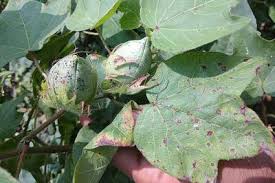
1. Black arm: This is a bacterial disease caused by Xanthomonas malvacearum. It attacks the leaves, stems, or bolls at any stage of growing.
It can cause seedling blight, which makes the leaves turn brown and dry up, or it can cause black lesions on older plant stems or branches which may break off. This phase is known as ‘black arm’.
If bolls are attacked, they rot, thereby causing cotton staining if the attack is mild, or total destruction if it is severe. Infected remains of the crop should be burnt to prevent a carry-over of the disease.
Seed dressing with a copper fungicide can prevent attack. The use of healthy seeds should be encouraged, and varieties that are resistant to attack should be planted.
2. Leaf curl: This is a virus disease whose vector is a white fly (Bemisia spp.). It causes the leaves to curl, and the plants become stunted and die. Infected plants should be burnt.
Pests Impacting Cotton Production
Pink boll worm (Platyedra gossypiella): The larvae, which have a double pink bar on each segment of the body, bore through minute holes into the cotton fruit, thus damaging it and reducing yield substantially. Some control is achieved by spraying carbaryl.
Jassids (Empoasca spp.): These are small green flies which bore holes in cotton leaves and cause them to curl. Cotton varieties with leaf hairiness discourage attack by these insects.
Diethoate 30% EC gives effective control of the insects. Mix the insecticide in 100 to 200 liters of water and spray thoroughly on the plants and leaves.
Cotton stainer (Dysdercus spp.): These insects with red, brown, and black markings are abundant in West Africa, often feeding on alternate host plants such as okra, when not attacking cotton.
They pierce the boll walls and introduce a fungus (Nematospora spp.) which stains the lint bright green, thus lowering the grade of the cotton.
Attack at an early stage causes shedding of bolls and yield reduction. Control is achieved by spraying carbaryl, but it is expensive.
Do you have any questions, suggestions, or contributions? If so, please feel free to use the comment box below to share your thoughts. We also encourage you to kindly share this information with others who might benefit from it. Since we can’t reach everyone at once, we truly appreciate your help in spreading the word. Thank you so much for your support and for sharing!

